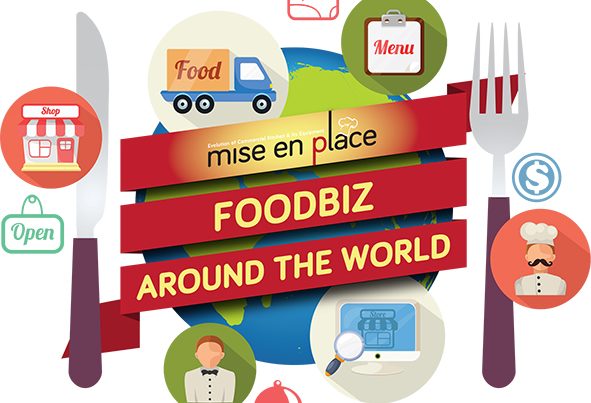
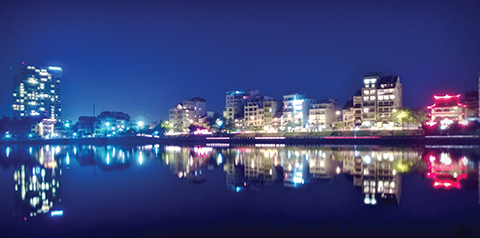
ABOUT VIETNAM
Welcoming tourists and visitors since the 1980s, Vietnam has rapidly developed a well-trodden trail of attractions over the years. Although the Americans, French, and Chinese have all left their own marks on the once colonized nation, Vietnam continues to prosper with its stunning geography, diverse cuisine, never-ending shopping and its fast-paced city life.
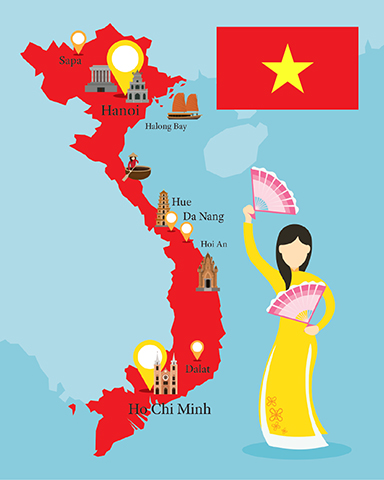
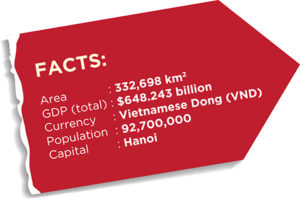
ECONOMY
Vietnam has had one of the ten fastest-growing economies in the world over the past decade, with average annual growth in per capita Gross Domestic Product (GDP) of 5.9% during 1992- 2002. It all started from the mid ‘80s, when Vietnam experienced a transformation from a central planning economy to a market-oriented economy, shifting from the low developed country league towards becoming a member of the middle income league.
The present economic structure in Vietnam strongly suggests that the country is still in an early stage of growth in many of its sectors. The top 3 industries in the list, in the order of GDP contribution, outlines industrials, consumer goods and consumer services. With consumer services on the rise thanks to its high-population emerging market, the food and beverage (F&B) sector is considered among the rising sectors in Vietnam.
SOCIAL
Vietnam holds a population of more than 90 million and is the third largest market in Southeast Asia after Indonesia and the Philippines. Home to a huge number of young people, that makes up 40 percent of whom are less than 25 years old, this growing population of young people will form the next generation of consumers and introduce bigger, creative opportunities for entrepreneurs tapping into emerging markets, especially the F&B sector.
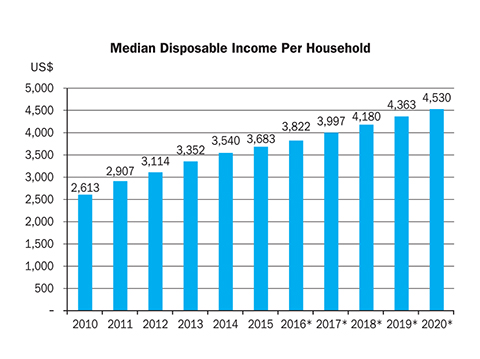
In fact, a Vietnamese consumer spent an average of 470,000 VND per month in 2015 on out-ofhome consumption, particularly for food. The steady increase in consumer expenditure is largely a result of rising incomes amid the strengthening of economic activity. Consumers appear to have strengthened confidence due to Vietnam’s bright economic outlook and low unemployment, which spurs confidence about their future earnings and results in a trend whereby consumer expenditure surpasses the rise in income.
BIG CITIES IN VIETNAM
People in the bigger cities of Vietnam, tend to eat out a lot, ranging from the sidewalk vendors to fine dining restaurants. This is changing the landscape of the F&B industry, creating a need of having greater choice of food and an expanded diversity of dietary options. To discuss this, let’s look at the two most populous cities in Vietnam, and how these cities garner more attention than others in the F&B sector of Vietnam.
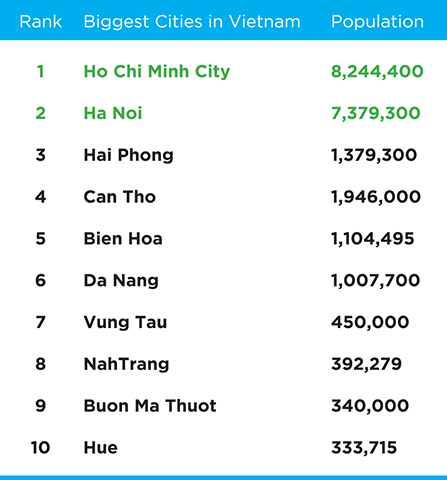
Vietnam has developed two independent and dominant urban systems – Ho Chi Minh City and Hanoi. Vietnam’s rapid economic growth is driven by these two urban systems with high growth and market concentration within these cities and their surrounding areas.
The average per-person basket size transactions in these two cities are:
Hanoi : 80,000 VND
Ho Chi Minh City : 70,000 VND
As much as these two cities top the list for out of- home consumption, and as cities best known for affordable street food, today, the street food segment in these cities represent only 11% of the total out-of-home F&B consumption. This shows that the urbanization in these two cities have created a fertile ground for startups in the F&B industry, setting a new tone for the industry in itself – as new concepts and consumer behaviors are emerging. Perhaps this would allow more startup entrepreneurs to capitalize on the increasingly lucrative market of Vietnam.
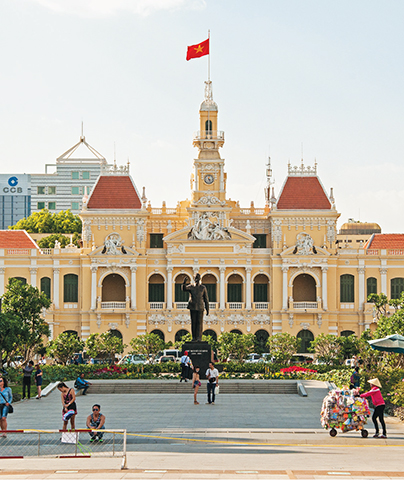
HO CHI MINH CITY
Ho Chi Minh, the buzzing and crazy commercial hub of Vietnam, is the most visited city in the country. It is the economic powerhouse of Vietnam and contributes up to 20% of the entire country’s GDP. Ho Chi Minh City also houses the largest Chinese community in the country, which makes it a diverse and vibrant community, although Vietnamese comprise 90% of the city’s aggregate population.
For many visitors, the cosmopolitan city offers an array of city sights, ranging from shopping spots to historical sites. In fact, about 70% of tourist visit the city due to the rich mix of French architecture found in colonial buildings, museums, restaurants, and various other historical structures.
Some of the well-known sites include:
• HCMC Museum
• Grand Notre Dame Cathedral
• Old district of Da Kao
• Jade Emperor Pagoda
• The History Museum
• The Reunification Palace
• The War Remnants Museum
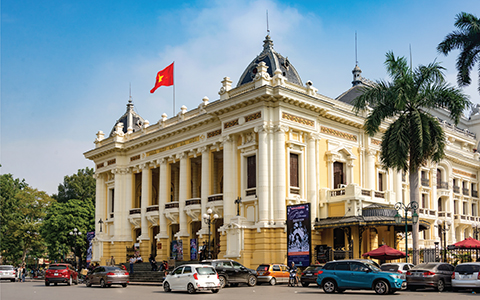
HANOI
This city is definitely the heartbeat of Vietnam, a place that brings traffic frenzy and city bustle as much as it charms travelers. However, if you want to dive into the Vietnamese city life, this capital city is definitely the place to do it. Not to mention, in the midst of noises are the many street vendors, selling cooked and raw food amongst other local delicacies.
Located along the right bank of the Red River, Hanoi is one of the fastest growing cities in the world in terms of GDP growth. The over 1000-year-old city has lakes and wide streets, as well as ancient and modern buildings. Besides being a main center for experiencing Vietnamese cultures, one can also see the unique imprint that the French left on the architecture and look of the city, and the influences of the Chinese colonists, from several hundred years ago.
Some of the places you can consider visiting in Hanoi are:
• Ho Chi Minh Mausoleum
• Vietnam Museum of Ethnology
• Vietnam Fine Art Museum
• Hanoi Opera House
• Hoan Kiem Lake
• Tran Quoc Buddhist pagoda
• Hanoi Zoo
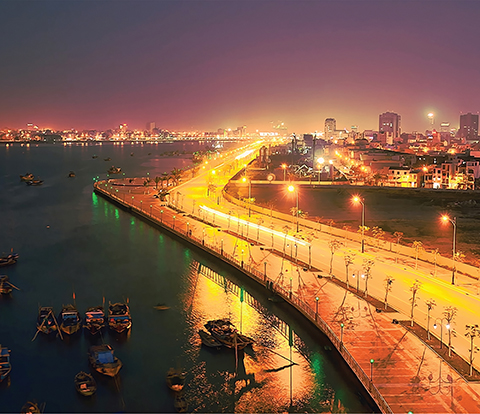
OTHER PLACES TO VISIT: DA NANG
Another city worth mentioning besides the two big cities is Da Nang. Although the city is not as populous as Ho Chi Minh City or Hanoi, Da Nang is listed as a first-class city for being the commercial and educational center of Central Vietnam, as well as one of the major port cities in Vietnam.
Tourism definitely plays a vital component of Da Nang’s economy. In fact, known for its sandy beaches and history as a French colonial port, Da Nang locates some of the most popular visiting bases among tourists in Vietnam. My Khe Beach definitely tops the list as tourists enjoy exciting marine activities during the festival season from April to July while being immersed in one the most beautiful beaches in the world.
Here are some places you can consider visiting in Da Nang:
• Marble Mountain
• Son Tra Peninsula
• Ba Na Hill
• Museum of Cham Sculpture
• Da Nang beaches
• Pham Van Dong Beach
• Bac My An Beach
• Non Nuoc Beach
• Dragon Bridge
• Han Market
EATING VIETNAMESE STYLE
THE REGIONAL DIFFERENCES
Food in Vietnam has distinctive flavors and can be divided into three distinct regions, the North, Central and the South. The north, where Hanoi is, appears mountainous and cooler and soups appear to play a large role in the cuisine. The famous Vietnamese pho soup is an example of a northern dish.
In the central region, the cuisine is rather different and consist of several small dishes. Hue was once the imperial Capital of the country and many delicate and creative dishes dedicated to the kings were invented here.
The cuisine in the southern region, on the other hand, is widely influenced by Thai flavours and appears spicier than the food found in other parts of the country. Where Ho Chi Minh City is located, coconut – based curries served with noodles and rice as well as a wide range of tropical fruits and vegetables are popular among visitors.
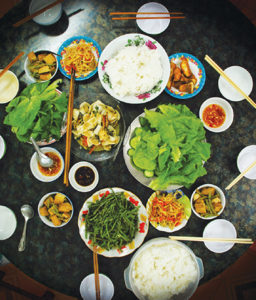 EATING THE “FAMILY STYLE”
EATING THE “FAMILY STYLE”The common notion of eating among Asians is often, sharing dishes or what we would call eating “family style.” The bowls of food set in the middle of the table, is shared with everyone while each gets a bowl of rice. Meat or seafood dishes, vegetable dishes, soup, and fish sauce for dipping – these dishes are typically the combination of a Vietnamese meal with rice. Noodles and vegetables are also included in the standard diet of most Vietnamese households.
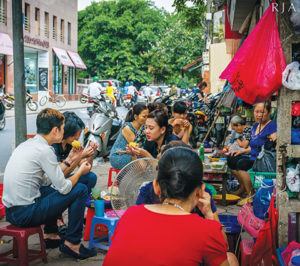 SIDEWALKS OF VIETNAM
SIDEWALKS OF VIETNAMThe best places for food exploration in Vietnam are not what you might typically expect coming from the U.S. or Europe. Some of the real places you want to try are likely the city sidewalks in a casual environment, where the cheapest and the most delicious places to eat are. Look for the small plastic stools and join the crowd of locals slurping down delicious bowls of soup – this is the typical restaurant culture in Vietnam.
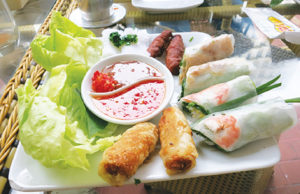 FUSION DINING
FUSION DININGAlthough the street food culture garners much attention in Vietnam, there are, however, some interesting fusion restaurants that showcase a blend of Vietnamese and French cuisine. In Hanoi, visitors can try soft-shell crab and other delicacies in the Ly Club served by waiters dressed in colonial style white suits – taking you back to days gone by. The riverbank in Hanoi meanwhile are lined with restaurants offering a mixture of traditional Vietnamese cuisine and dishes from the rest of Asia.
DEDICATED RESTAURANTS AND SPECIALTY MEAL
There are specific street vendors in the streets of Vietnam that specialise in a particular dish. Some streets in Hanoi’s Old Quarter are particularly named after specialties or crafts. Green papaya salad, chicken salad, noodles for a delicious breakfast and duck for an afternoon meal – this area has several narrow alleyways that you can spend time in whilst in Hanoi.
Hang Mam is called the street of fish sauces while Hang Thie is known as the street of tinsmiths and tin shops. To experience the specialty meals, you can perhaps embark on a progressive buffet by starting with the vendor who specialises in spring rolls, followed by the best pho soup vendor, and end with the renowned chè vendor in town.
The two main types of food service establishments in Vietnam are full-service restaurants and street vendors. Based on the two major cities of Vietnam – Hanoi and Ho Chi Minh City, below are the prices of local food and beverages for the establishments. Now, let’s take a look at an extended list of some the local favorites you can try for an authentic Vietnamese food tour.
Bun Cha
Bun cha is a staple dish across Hanoi, which most working people sneak out to grab for a quick and cheap lunch. Often served with spring rolls at street stalls or pop up restaurants, the succulent meat, broth and noodles come with fresh herbs, salt, garlic and chili.
Pho
Sold by street vendors everywhere and available all day, this rice noodle soup served with an array of tasty broths is often accompanied by fresh mint, lime, chili and sugar. The broth tends to be seasoned with anise, a sweet spice that isn’t used so much in Western cooking. Besides the commonly added thinly sliced beef, some other versions of this dish include meat and vegetarian options.
Bun Bo Hue
Bun bo Hue, another noodle soup dish is the food icon of Vietnam’s central region. Fresh herbs, beef and/or pork are added to a meaty broth accented with lemongrass.
Banh Xeo
Saigon’s pancakes, banh xeos are lightly fried and served with condiments including the ubiquitous fish sauce, lime and chili. These late night snacks can be ideal for a sit in or even take away in smaller portions.
Banh Mi (Vietnamese Baguette)
This French-style baguette is filled with any combination of pâté, pork, carrot, mint, beansprouts, coriander and pickle. For those looking for a break from noodles, this meal is one buy away from a street stall and an easy eat on the go.
Chè Or Vietnamese Soup Desserts
You will not want to miss the Chè, or other traditional dessert soups. There are many different kinds of chè, served hot or cold, along the streets of Vietnam.
Cà Phê ðá (Vietnamese Iced Coffee)
This unique Vietnamese iced coffee, also known as cà phê ðá is a traditional Vietnamese coffee recipe, a must try for visitors. The coffee is made using medium to coarse ground dark roast of Vietnamese grown coffee with a small metal Vietnamese drip filter. Order it “có phin” and you will get your very own coffee drip system.
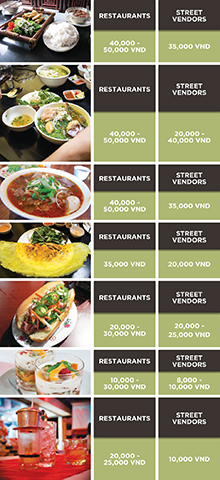
LOCAL HOTSPOTS
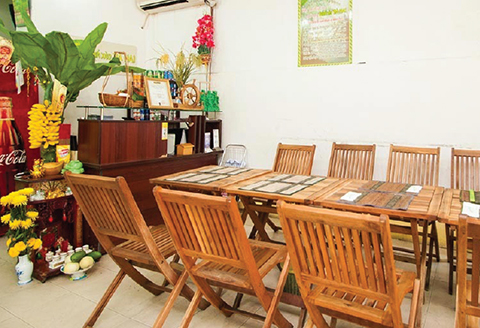
Banh Xeo Ba Hai
Banh Xeo Ba Hai is definitely a low-profile hotspot compared to the other best-known banh xeo eateries in Ho Chi Minh City, such as Banh Xeo Muoi Xiem and Banh Xeo 46A. Although these giants have won major awards and are featured on numerous travel shows, what makes Banh Xeo Ba Hai different is instead of using lettuce, basil, herbs, and other common vegetables, the banh xeo here is served with wild herbs collected fresh from the forests.
This place is as equally recognized among locals and tourists for serving up 12 types of pancakes, including a number of vegetarian options. Not only the crust is crispy and the stuffing generous, the crepes also appear less greasy than the other places which makes it a considerably healthy option for visitors.
Banh Xeo Ba Hai offers both indoor and outdoor seating, particularly a pleasant atmosphere inside and has friendly staff to suggest you other known dishes in this place.
Address : 64 Nguyen Trong Tuyen, 15, Phu Nhuan, Ho Chi Minh, Vietnam.
Phone : +84873006099
Opening hours : 10am – 10pm daily
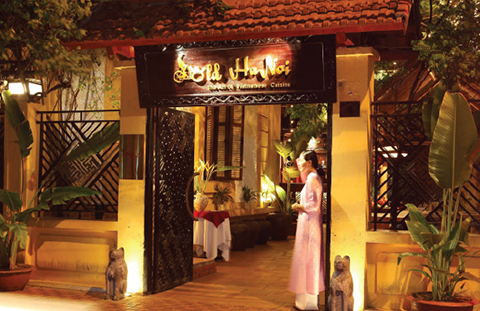
Old Hanoi Restaurant
Hanoi’s French legacy is most visible in the city’s adoption of architecture, and most definitely – its dining culture. Located in the center of Hanoi, this sophisticated eatery occupies a restored Frenchcolonial villa, featuring a classy dining section fitted with antiques, oriental-style furnishings and warm lighting.
It also presents a pleasant casual courtyard outside fringed with bamboo trees. For those wanting a quieter atmosphere, Old Hanoi offers the use of one of three VIP rooms or dining on the terrace.
The restaurant serves traditional Hanoian and Vietnamese specialties with aplomb, and is especially known for its authentic Vietnamese cuisine. Included in the standout list is steamed goat in bamboo pot, banh xeo with shrimp and pork served in a clay pot, and grilled fish Old Hanoi-style.
As the restaurant aims at keeping the flavours truly Hanoian, especially through the emphasis of fresh quality ingredients, sourced locally, it is no surprise that this place was once visited by the world’s renowned culinary personality, Chef Gordon Ramsay.
Address : 4 Ton That Thiep Street, Ba Dinh District, Hanoi, Vietnam.
Phone : +84437478337
Opening hours : 7am – 11.30pm daily
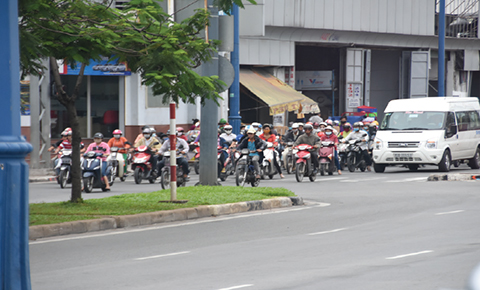
VIETNAM’S STARTUP ECOSYSTEM
Although Vietnam has a largely homogeneous ethnicity and activities, there has been a steady bloom of startups in the country. While a lot of people have considered this pattern to have started in the past year, the government is beginning to show some support by changing the laws, hosting events, and initiating some accelerators for the F&B industry.
HIRING
One of the big advantages of establishing a business in Vietnam is the great pool of talent with low operation costs. Local salaries for admins to coders range from $500 – $1500 USD a month, and the working crowd also appear to be more serious and focused on execution. This explains why there are numerous bootstrappers especially in the Ho Chi Minh City.
TECHNOLOGY
Vietnam is also well-connected to the new media world as up to 50 percent of the country’s population is on the internet and more than a third use smartphones. However, this appears different for the business world as not all firms are embracing technology quickly. While industries in the larger cities use e-mail, Internet, and laptops, firms in other parts of Vietnam clearly lag behind those in the bigger cities.
Firms in Ho Chi Minh City seem to have an easier time recruiting employees, as they appear to have the best information about technology and market demand. This is a key issue that startups should be reminded of in order to encourage constant technology transfer within Vietnam, and not give up easily on areas where “low technology” reside.
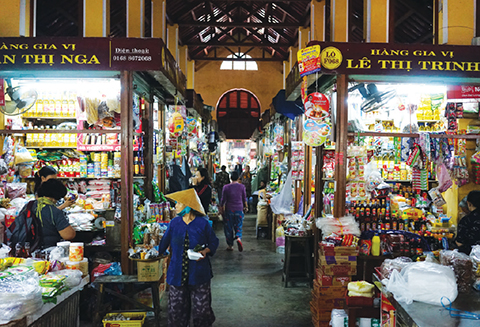
STARTING A BUSINESS IN VIETNAM
Before discussing the detailed summary of registering a new restaurant or F&B business in Vietnam, here are some questions that entrepreneurs may want to answer before stepping into a startup.
• What is your startup concept – Vietnamese or Western foodservice?
• Will your starting capital suffice for advanced rentals and registration expenses?
• Where is your startup headquartered?
• Are you focusing on daily consumption or occasions?
• Are you planning to launch online ordering?
• What is the affordability of the food segment you have chosen?
• What is the actual addressable market for your food segment?
• How big is the market opportunity?
• What is the existing competition within your food segment?
• How do you see your startup in 5 years?
After answering these questions, entrepreneurs wishing to incorporate and register a startup in Vietnam have to examine the procedures, time and cost involved in launching a business in Vietnam. The business will, of course, consider between 10 and 50 employees and require a startup capital of 10 times the economy’s per-capita gross national income.
Here are some bureaucratic and legal steps in registering your startup.
Step 1 : Business Registration
• Entrepreneurs wishing to register a new firm needs to check the proposed company name before obtaining a business registration certificate and a tax registration certificate.
Agency : Business Registration Office, Department of Planning & Investment
Cost : 200,000 VND (official fees)
• Obtain a company seal. The seal-sample must be sent to the Business Registration Office to be published on the National Business Registration Portal.
Agency : Sealmaker
Cost : 165,000-370,000 VND for bronze seal
Step 2 : Open A Bank Account
Each bank varies in the minimum deposit required to open an account. Vietcombank may require the fixed amount of 1 million VND for an account in VND and 300 USD for one in USD. Asian Commercial Bank, on the contrary, may require 1 million VND for a VND account and 100 USD for a USD account. Some documents required in opening the account is application form, the company seal, business registration certificate, and the resolution of the management board on the authorized signatures (if applicable).
Agency : Bank
Step 3 : Taxation
• Buy pre-printed VAT invoices from the Municipal Taxation Department or obtain self-printed VAT invoices. It takes about 10 days to get the printed VAT invoices and register them with the Municipal Taxation Department. Agency : Municipal Taxation Department
Cost : 200,000 VND per book
• Pay business license tax by registering tax reports or through designated commercial banks. The business license tax is paid annually and in the first month of a year (with regards to operating enterprises), as well as the month when the newly established enterprise obtains the tax registration certificate and tax code.
Agency : Tax office or commercial bank
Cost : 1,000,000 VND (for business license tax)
Step 4 : Publishing
Publish the registration contents on the National Business Registration Portal (NBRP).
Agency : National Business Registration Portal (NBRP)
Cost : 300,000 VND
Step 5 : Labor Registration
• The new firm needs to register with the local labour office to declare the use of labour within 30 days of starting operations.
Agency : Municipal Department for Labor, Invalids
and Social Affairs
Cost : No charges
• The company must also register all employees who have contracts for 3 months or longer with the Social Insurance Fund, for the payment of health insurance and social insurance.
Agency : Social Insurance Fund
Cost : No charges
VIETNAMESE TRADE AGREEMENTS
Vietnam expects to reach an income per capita of 15,000,000 VND by year 2020. The annual growth rate will remain at 6%, and the F&B consumption is expected to catch up with this growth.
In fact, the Vietnamese government particularly aims to allow this sector to grow as sustainably as it can. Free trade agreements with different countries and regional groups have been aggressively pursued upon, and that includes the ASEAN Free Trade Area, Chile-Viet Nam Free Trade Agreement, Japan-Viet Nam Economic Partnership Agreement, and the Viet Nam- European Union Free Trade Agreement. Recently, the Vietnamese government also approved the Vietnam-Finland Innovation Partnership Program (IPP), which supports Vietnam’s overall goal of becoming a middle income knowledge economy by the year 2020.
EVENTS OF INTEREST
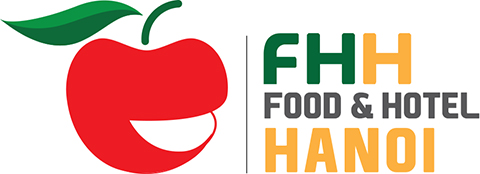
FOOD & HOTEL HANOI 2018
Backed by a solid proven track record of success of Food&HotelVietnam staged in Ho Chi Minh City, Food&HotelHanoi has been launched to offer a direct route for international exporters and suppliers to the Northern Vietnam’s burgeoning food and hospitality industries. The inaugural edition is taking place from 28 to 30 November 2018 in
the International Center for Exhibition (I.C.E) Hanoi, with a packed programme of exciting culinary and barista competitions; insightful talks, workshops and seminars; not to mention the comprehensive product showcase spanning across 4,300 square meters of the exhibition space. Over 200 companies from 20 countries and regions, including 14 group pavilions, are ready to introduce an extensive assortment of top-notch products and services to thousands of interested buyers. From food and beverages, food ingredients, catering equipment, specialty coffee equipment, bakery equipment, tableware and furnishing, to disruptive technology for back-end foodservice and front-end guest experiences, Food&HotelHanoi caters to the diverse needs of the Northern Vietnam’s thriving markets.
Date : 28 – 30 November 2018
Venue : International Center for Exhibition (I.C.E), Hanoi, Vietnam
Website : http://foodnhotelhanoi.com
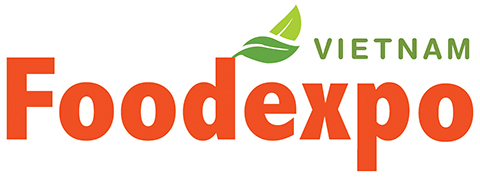 VIETNAM
VIETNAM
FOODEXPO 2017
Vietnam Foodexpo bridges the future’s sustainable growth market with the current food trade and food production. The exhibition is one of the most important trade events in Vietnam’s food industry, as it is the only sourcing platform in Vietnam which is able to gather and feature the leading food manufacturers and exporters in the country with the best products on offer. Besides business matching services tailor-made to each visitor’s requests, the exhibition offers visitors a unique chance to meet with 300 Vietnamese exhibitors including the leading companies in Vietnam’s food industry and around 100 international exhibitors from 15 foreign countries.
Date : 15 – 18 November 2017
Venue : Saigon Exhibition and Convention Center, Ho Chi Minh, Vietnam
Website : https://foodexpo.vn

FOOD INGREDIENTS VIETNAM 2018
This three-day event features a stage where several primary solutions and products are to be put on show. These event will mainly talk about the F&B products, food processing and food ingredients. Not only that, visitors will get to meet the key high-level food industry professionals all in one place, which is definitely an effective way to source food and beverage ingredients and meet the right suppliers for your business. This is a great chance both for startups, SMEs, and multinational companies as local markets are still developing. Organized biennially by UBM, the trade show is anticipated to be participated by 3600 guests in the coming year.
Date : 16 – 18 May 2018
Venue : Saigon Exhibition and Convention Center, Ho Chi Minh, Vietnam
Website : http://www.figlobal.com/vietnam







